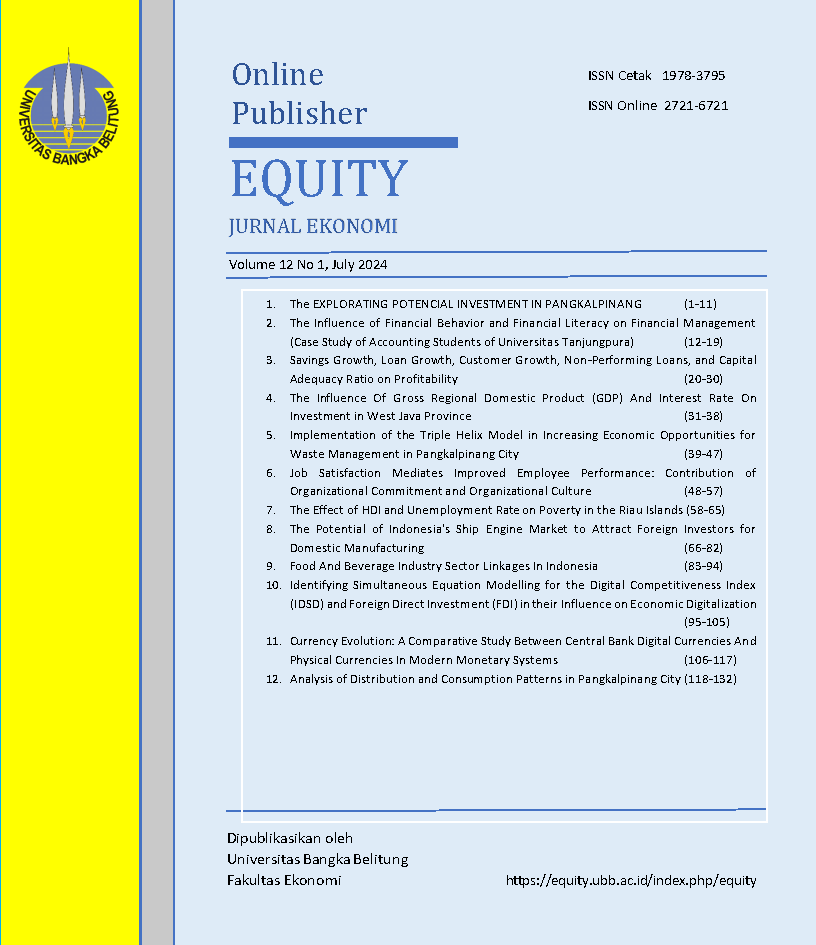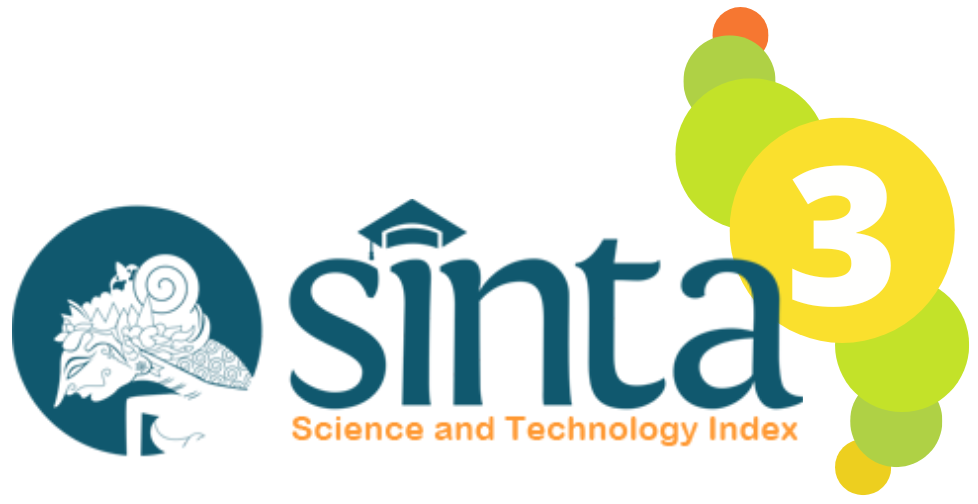The Potential of Indonesia's Ship Engine Market to Attract Foreign Investors for Domestic Manufacturing
DOI:
https://doi.org/10.33019/equity.v12i1.294Keywords:
Main Engine, Maritime Industry, New InvestorsAbstract
Indonesia is a prospective country for everyone to decide on an investment. There are four reasons to strengthen the motivation to invest some capital in the maritime industry sector. Moreover, Indonesia has approximately 342 shipbuilding companies and 127 ship component companies which spread out throughout the nation. However, Indonesia has no engine maker company yet and this is an opportunity for all investors who want to establish their own engine company or a branch in this country. The biggest opportunity is in the fishery sector with a growing number of fishing vessels and the Indonesian marine fishery production potential as the largest archipelagic country is still increasing. Furthermore, other opportunities are passenger ships, cargo ships, and tug boats because they have a significant number in the nation. In addition, Indonesia also gives several incentives to new investors, like a tax allowance, a super tax deduction, and an import duty facility. Ultimately, the prospect has been considered to involve responsibilities among shipowners, shipyards, main engine manufacturers, and the government.
Downloads
References
Al-Haq, F. A. (2024, February 28). Indonesia matters: Emerging market to economic powerhouse. Sekretariat Kabinet Republik Indonesia. https://setkab.go.id/indonesia-matters-emerging-market-to-economic-powerhouse/#:~:text=As%20the%207th%20largest%20economy,lighting%20the%20fire%20of%20growth
Badan Pusat Statistik. (2019, January 10). Jumlah perahu/kapal menurut provinsi dan jenis perahu/kapal, 2000-2016. Pertanian, Kehutanan, Perikanan. https://www.bps.go.id/id/statistics-table/1/MTcxMCMx/jumlah-perahu-kapal-menurut-provinsi-dan-jenis-perahu-kapal--2000-2016.html
Badan Pusat Statistik. (2022, May 23). Produksi perikanan laut yang dijual di TPI. Pertanian, Kehutanan, Perikanan. https://www.bps.go.id/id/statistics-table/2/NDk2IzI=/produksi-perikanan-laut-yang-dijual-di-tpi.html
Badan Pusat Statistik. (2023, November 20). Data ekspor impor nasional. BPS. https://www.bps.go.id/exim
Divisi Material dan Komponen. (2023). Populasi kapal di Indonesia. Jakarta: PT. Biro Klasifikasi Indonesia.
Divisi Material dan Komponen. (2023). Total jenis mesin kapal. Jakarta: PT. Biro Klasifikasi Indonesia.
Divisi Material dan Komponen. (2024). Jumlah kapal terregistrasi di Indonesia. Jakarta: PT. Biro Klasifikasi Indonesia.
Direktorat Jenderal Perhubungan Laut. (2023). Jumlah kapal barang (kargo). Jakarta: Kementerian Perhubungan.
Direktorat Jenderal Perhubungan Laut. (2023). Jumlah kapal ikan. Jakarta: Kementerian Perhubungan.
Direktorat Jenderal Perhubungan Laut. (2023). Jumlah kapal penumpang. Jakarta: Kementerian Perhubungan.
Direktorat Kapal Perikanan dan Alat Penangkap Ikan. (2023). Jenis-jenis mesin kapal ikan. Jakarta: Kementerian Kelautan dan Perikanan.
Kementerian Perhubungan. (2012, November 24). Perbaikan dan pembangunan pelabuhan dan sarana logistik. Kolom Redaksi. https://dephub.go.id/post/read/perbaikan-dan-pembangunan-pelabuhan-dan-sarana-logistik-15267
Kementerian Perindustrian. (2022, June 24). Peta persebaran industri maritim Indonesia. Sistem Informasi Industri Nasional. siinas.kemenperin.go.id
Kementerian Perindustrian. (2022, June 25). Distribusi industri komponen kapal Indonesia. Sistem Informasi Industri Nasional. siinas.kemenperin.go.id
Kementerian Perindustrian. (2023, November 22). Overview ekspor dan impor Indonesia. Sistem Informasi Industri Nasional. siinas.kemenperin.go.id
Kementerian Perindustrian. (2023, November 26). Overview ekonomi makro Indonesia. Sistem Informasi Industri Nasional. siinas.kemenperin.go.id
Lichun Sui, J. W. (2020). Spatial-temporal characteristics of coastline changes in Indonesia from 1990 to 2018. MDPI: Sustainability, 1-29.
Martono, N. (2010). Metode penelitian kuantitatif: Analisis isi dan analisis data sekunder. Rajawali Pers.
McGillivray, M. (2023). Human development index. In Elgar Encyclopedia of Development (pp. 331–335). Elgar. https://doi.org/10.4337/9781800372122.ch69
Ridwan Firadlan, I. A. (2021). Analysis of factors affecting investment in Indonesia. International Journal of Economics, Business and Accounting Research (IJEBAR), 1078-1089.
Rivera-Batiz, F. L., & Spatareanu, M. (2020). Encyclopedia of international economics and global trade. Singapore: World Scientific Publishing Co. Pte. Ltd.
Rotua Andriyati Siregar, A. P. (2021). The impact of tax incentives on foreign direct investment in Indonesia. Journal of Accounting Auditing and Business, 67-80.
Schumahrer, R. (2012). Adam Smith’s theory of absolute advantage and the use of doxography in the history of economics. Erasmus Journal for Philosophy and Economics, 54-80.
Sri Wahyuni, I. H. (2024). The role of theory in forming economic policy: Agrowth theory perspective. Indonesian Interdisciplinary Journal of Sharia Economics (IIJSE), 801-818.
Sukron, I. (2021). Pengaruh IPM, pengangguran dan pertumbuhan ekonomi terhadap kemiskinan di provinsi Jawa Tengah. INDEPENDENT: Journal of Economics, 1(3), 47–65.
Suryani, F. S., Sendi, M., & Silalahi, P. R. (2023). Pengaruh IPM dan PDRB terhadap jumlah penduduk ekonomi tingkat rendah (miskin) di Sumatera Utara. Jurnal Ekonomi dan Manajemen, 3(1).
Xinxin Wang, Z. X. (2021). Foreign direct investment and economic growth: A dynamic study of measurement approaches and results. Economic Research-Ekonomska Istraživanja, 1011-1034.
Downloads
Published
Issue
Section
License
Authors who publish journals in Equity: Jurnal Ekonomi agrees with the following conditions:
1. Authors retain copyright and grant the journal right of first publication with the work simultaneously licensed under a Creative Commons Attribution 4.0 International License.
2. Authors are able to enter into separate, additional contractual arrangements for the non-exclusive distribution of the journal's published version of the work (e.g., post it to an institutional repository or publish it in a book), with an acknowledgement of its initial publication in this journal.
3. Every publication (printed/electronic) are open access for educational purposes, research, and library. Other than the aims mentioned above, the editorial board is not responsible for copyright violation.














